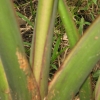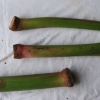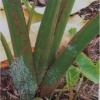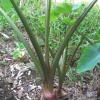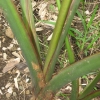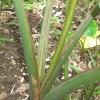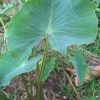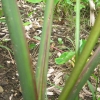Use As Food
Makes a red poi of good quality. Taro of this family are common grown in lo‘i (wetland), and are very tough with a resistance to root rot. Goup piko are known to make good poi.
Distribution
Apparently rare; has done well under upland, dryland culture (māla).
General Characteristics
Medium in height, erect, moderately stocky, maturing within 12 to 15 months, producing from 5 to 10 ‘ohā; distinguished from Piko Lehua-apei by lack of crinkled tissue on Lau or lū ‘au (Leaf blade) and from other Piko varieties by the lilac-purple ‘i‘o kalo (Corm) flesh.
Ha (Petiole)
75 to 100 cm. long, dark green with dark brown shading near kōhina (base) an 1 a narrow reddish-purple edge, a dark reddish purple ring at kōhina (base) with lighter reddish-purple flecked area for 3 to 5 cm. above.
Lau or Lu'au(Leaf Blade)
35 to 50 cm. long, 25 to 35 cm, wide, 25 to 40 cm. from tip to base of sinus (māwae), arrow head shaped, chartaceous (paper like), dark green with bluish cast; round leaf section (lobes) acute with narrow lihi māwae (sinus).
'I'o kalo (Corm)
Flesh lilac-purple with dark lilac-purple fibers; Skin dark lilac-pink.
Pua (Flower)
Remarks

